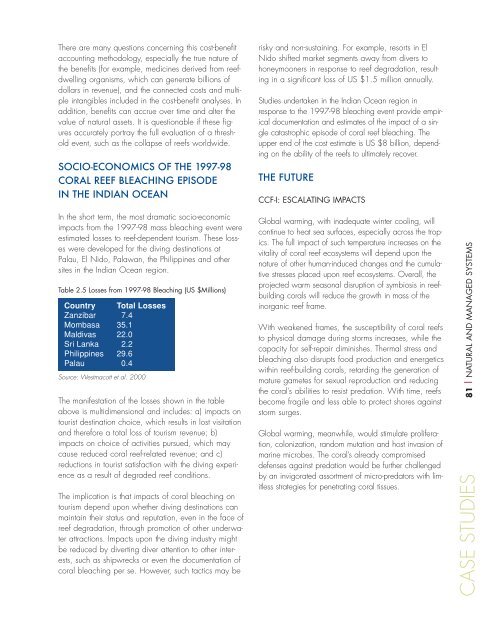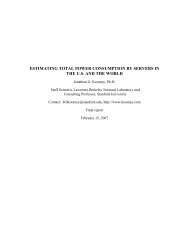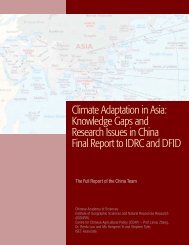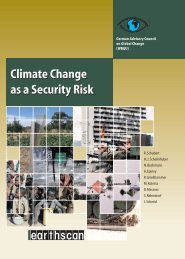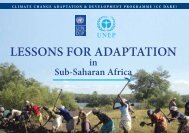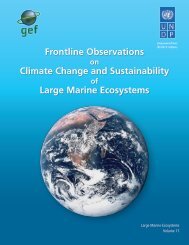There are many questions concerning this cost-benefitaccounting methodology, especially the true nature ofthe benefits (for example, medicines derived from reefdwellingorganisms, which can generate billions ofdollars in revenue), <strong>and</strong> the connected costs <strong>and</strong> multipleintangibles included in the cost-benefit analyses. Inaddition, benefits can accrue over time <strong>and</strong> alter thevalue of natural assets. It is questionable if these figuresaccurately portray the full evaluation of a thresholdevent, such as the collapse of reefs worldwide.SOCIO-ECONOMICS OF THE 1997-98CORAL REEF BLEACHING EPISODEIN THE INDIAN OCEANIn the short term, the most dramatic socio-<strong>economic</strong>impacts from the 1997-98 mass bleaching event wereestimated losses to reef-dependent tourism. These losseswere developed for the diving destinations atPalau, El Nido, Palawan, the Philippines <strong>and</strong> othersites in the Indian Ocean region.Table 2.5 Losses from 1997-98 Bleaching (US $Millions)Country Total LossesZanzibar 7.4Mombasa 35.1Maldivas 22.0Sri Lanka 2.2Philippines 29.6Palau 0.4Source: Westmacott et al. 2000The manifestation of the losses shown in the tableabove is multidimensional <strong>and</strong> includes: a) impacts ontourist destination choice, which results in lost visitation<strong>and</strong> therefore a total loss of tourism revenue; b)impacts on choice of activities pursued, which maycause reduced coral reef-related revenue; <strong>and</strong> c)reductions in tourist satisfaction with the diving experienceas a result of degraded reef conditions.The implication is that impacts of coral bleaching ontourism depend upon whether diving destinations canmaintain their status <strong>and</strong> reputation, even in the face ofreef degradation, through promotion of other underwaterattractions. Impacts upon the diving industry mightbe reduced by diverting diver attention to other interests,such as shipwrecks or even the documentation ofcoral bleaching per se. However, such tactics may berisky <strong>and</strong> non-sustaining. For example, resorts in ElNido shifted market segments away from divers tohoneymooners in response to reef degradation, resultingin a significant loss of US $1.5 million annually.Studies undertaken in the Indian Ocean region inresponse to the 1997-98 bleaching event provide empiricaldocumentation <strong>and</strong> estimates of the impact of a singlecatastrophic episode of coral reef bleaching. Theupper end of the cost estimate is US $8 billion, dependingon the ability of the reefs to ultimately recover.THE FUTURECCF-I: ESCALATING IMPACTSGlobal warming, with inadequate winter cooling, willcontinue to heat sea surfaces, especially across the tropics.The full impact of such temperature increases on thevitality of coral reef ecosystems will depend upon thenature of other human-induced <strong>change</strong>s <strong>and</strong> the cumulativestresses placed upon reef ecosystems. Overall, theprojected warm seasonal disruption of symbiosis in reefbuildingcorals will reduce the growth in mass of theinorganic reef frame.With weakened frames, the susceptibility of coral reefsto physical damage during storms increases, while thecapacity for self-repair diminishes. Thermal stress <strong>and</strong>bleaching also disrupts food production <strong>and</strong> energeticswithin reef-building corals, retarding the generation ofmature gametes for sexual reproduction <strong>and</strong> reducingthe coral’s abilities to resist predation. With time, reefsbecome fragile <strong>and</strong> less able to protect shores againststorm surges.Global warming, meanwhile, would stimulate proliferation,colonization, r<strong>and</strong>om mutation <strong>and</strong> host invasion ofmarine microbes. The coral’s already compromiseddefenses against predation would be further challengedby an invigorated assortment of micro-predators with limitlessstrategies for penetrating coral tissues.81 | NATURAL AND MANAGED SYSTEMSCASE STUDIES
82 | NATURAL AND MANAGED SYSTEMSCASE STUDIESIMPACT ON FISHERIESPopulation reductions have been predicted for speciesthat inhabit reefs for at least part of their life cycle orthat prey on smaller reef fish. Changes in fish abundancewould vary by species, shifting the net compositionof reef fish populations toward herbivores. Such ashift would negatively impact fishermen, as herbivoresare lower in value than other species. When bleachingis superimposed on reefs that are already overfished,reductions in overall reef fish populations wouldnot be expected, since herbivores would have dominatedthe fishery prior to the bleaching event. Impactsoccurring at small spatial or temporal scales would bemasked by fishermen changing their fishing habits <strong>and</strong>patterns. The impacts upon fisheries may become morepronounced once the structural frame of bleachedreefs is eroded.CCF-II: SURPRISE IMPACTSWith nearly 60% of the world’s reefs threatened bybleaching, pollution <strong>and</strong> disease, it is plausible to projecta collapse of coral reefs in the next severaldecades. Just 1°C additional warming of sea surfacetemperatures could bleach the entire ring of coralreefs.Costing the loss of Earth’s oldest habitat makes littlesense. The <strong>economic</strong> valuation of about US $800 billionfor the world’s reefs may vastly underestimate theirirreplaceable role. The <strong>economic</strong> <strong>and</strong> social value ofassuring the survival of coral reefs <strong>and</strong> the ecosystemsassociated with them (that is, seagrasses, mangroves,beach <strong>and</strong> upl<strong>and</strong> communities) is not possible toquantify.Potential <strong>economic</strong> impacts following the collapse ofcoral reef ecosystems are of great concern. Recoveryof damages to tourist-related structures (including shorelinehotels, losses of homes, roads <strong>and</strong> bridges) wouldrequire major financial support. Economic resourceswould be necessary to repair storm-damaged properties(homes, buildings, piers, boats), to meet elevatedlocal <strong>health</strong> care costs stemming from environmental illnesses,<strong>and</strong> also to compensate unemployed localworkers. The loss of reefs as tourist attractions <strong>and</strong> theloss of reef protection against storm surge, togetherwith sea level rise, will create socio-<strong>economic</strong> catastrophesin low-lying isl<strong>and</strong>s <strong>and</strong> coastlines.Tourism in the Caribbean generates over US $16 billionannually. The combination of sea level rise, coralreef destruction, more intense storms, more powerfulstorm surges, <strong>and</strong> more epidemics of vector-borne diseases(such as dengue fever) collectively pose substantialrisks for tourism, travel <strong>and</strong> allied industries.Disruption of low-lying coastal areas <strong>and</strong> isl<strong>and</strong> lifefrom the combination of saltwater intrusion intoaquifers, the loss of barrier <strong>and</strong> fringing reefs, <strong>and</strong>more intense tropical storms could displace manyisl<strong>and</strong> <strong>and</strong> low-lying nation populations, resulting inheightened political <strong>and</strong> <strong>economic</strong> pressures on othernations. The generation of large numbers of environmentalrefugees <strong>and</strong> internally displaced persons maypresent the greatest short-term costs to internationalsecurity <strong>and</strong> stability.SPECIFIC RECOMMENDATIONSThe full impacts of global warming may be delayedby reducing the direct anthropogenic threats to coralsurvival. Direct contact between tourists <strong>and</strong> coral,boat <strong>and</strong> anchor damage, release of debris <strong>and</strong>chemical pollutants around reefs, <strong>and</strong> unsustainableharvesting activities for recreation <strong>and</strong> commerce aredetrimental to reef resilience. Marine Protected Areasprovide the framework for preserving these vital areas.Implementation of conservation measures must be comprehensivein order to have a substantial <strong>and</strong> lastingeffect. The measures include:• Treatment of domestic sewage to tertiary breakdownlevels before release into far-offshore marine environments.• Reduced use of fertilizers <strong>and</strong> pesticides in nearshorecoastal communities.• Implementing fishing quotas, establishing ‘no-go’zones <strong>and</strong> seasons, <strong>and</strong> designating temporary noharvestingzones, to allow for replenishment <strong>and</strong>protection of shellfish <strong>and</strong> finfish stocks.• Preserve contiguous areas of the interconnectedupl<strong>and</strong> forest <strong>and</strong> watershed systems, coastal wetl<strong>and</strong>s,mangrove st<strong>and</strong>s <strong>and</strong> spawning lagoons.• Adhering to regulations regarding Marine ProtectedAreas <strong>and</strong> restricted access zones along coastalareas.• Banning <strong>and</strong> monitoring compliance for destructivefishing practices, for example, dynamite <strong>and</strong>cyanide used for fishing, <strong>and</strong> removal of reefs forconstruction.
- Page 1 and 2:
Climate Change FuturesHealth, Ecolo
- Page 4 and 5:
Table of ContentsIntroductionPart I
- Page 6 and 7:
EXECUTIVE SUMMARYClimate is the con
- Page 8 and 9:
the past decade, an increasing prop
- Page 10 and 11:
THE CASE STUDIES IN BRIEFInfectious
- Page 12 and 13:
THE INSURER’S OVERVIEW:A UNIQUE P
- Page 14:
Regulators and governments can empl
- Page 17 and 18:
THE PROBLEM:CLIMATE IS CHANGING, FA
- Page 19 and 20:
Figure 1.3 GreenlandEXTREMESOne of
- Page 21 and 22:
20 | THE CLIMATE CONTEXT TODAYWholl
- Page 23 and 24:
Figure 1.5 Global Weather-Related L
- Page 25 and 26:
Climate signals in rising costs fro
- Page 27 and 28:
CLIMATE CHANGE CANOCCUR ABRUPTLYPer
- Page 29 and 30:
28 | THE CLIMATE CONTEXT TODAYCCF-I
- Page 31 and 32: communities, salinizing ground wate
- Page 33 and 34: Health is the final common pathway
- Page 35 and 36: 34 | INFECTIOUS AND RESPIRATORY DIS
- Page 37 and 38: Figure 2.4 Malaria and Floods in Mo
- Page 39 and 40: Figure 2.61920-1980CASE STUDIES38 |
- Page 41 and 42: A MALARIA SUCCESSThe New York Times
- Page 43 and 44: A new flavivirus, Usutu, akin to WN
- Page 45 and 46: 44 | INFECTIOUS AND RESPIRATORY DIS
- Page 47 and 48: One analysis (Vanderhoof and Vander
- Page 49 and 50: BIODIVERSITYBUFFERS AGAINSTTHE SPRE
- Page 51 and 52: Figure 2.15 RagweedMOLDSLong-term f
- Page 53 and 54: ASTHMA COSTSTODAYexamples, the Afri
- Page 55 and 56: Stott et al. (2004) calculate that
- Page 57 and 58: In the summer of 2005, northern Spa
- Page 59 and 60: a better understanding of subpopula
- Page 61 and 62: 60 | EXTREME WEATHER EVENTSFLOODSFO
- Page 63 and 64: MOSQUITO- AND SOIL-BORNE DISEASESEC
- Page 65 and 66: Table 2.2 Direct and Indirect Healt
- Page 67 and 68: HEALTH AND ECOLOGICALIMPLICATIONSOu
- Page 69 and 70: 68 | NATURAL AND MANAGED SYSTEMSCAS
- Page 71 and 72: Figure 2.27 Soybean Sudden Death Sy
- Page 73 and 74: 72 | NATURAL AND MANAGED SYSTEMSCAS
- Page 75 and 76: 74 | NATURAL AND MANAGED SYSTEMSCAS
- Page 77 and 78: 76 | NATURAL AND MANAGED SYSTEMSCAS
- Page 79 and 80: 78 | NATURAL AND MANAGED SYSTEMSTHE
- Page 81: HARMFUL ALGALBLOOMSFigure 2.32 Red
- Page 85 and 86: CASE STUDIES 84 | NATURAL AND MANAG
- Page 87 and 88: CASE STUDIES 86 | NATURAL AND MANAG
- Page 89 and 90: CASE STUDIES 88 | NATURAL AND MANAG
- Page 91 and 92: CASE STUDIES 90 | NATURAL AND MANAG
- Page 93 and 94: “Climate change is one of the wor
- Page 95 and 96: 94 | FINANCIAL IMPLICATIONS• Incr
- Page 97 and 98: Extreme weather events are a partic
- Page 99 and 100: 98 | FINANCIAL IMPLICATIONSTable 3.
- Page 101 and 102: 100 | FINANCIAL IMPLICATIONSdemand
- Page 103 and 104: 102 | FINANCIAL IMPLICATIONSClimate
- Page 105 and 106: These include:Solar Photovoltaic Pa
- Page 107 and 108: • Social and economic factors in
- Page 109 and 110: Finally, new technologies need to b
- Page 111 and 112: 110 | FINANCIAL IMPLICATIONSBRETTON
- Page 113: 112 | APPENDICESAppendix A. Summary
- Page 116 and 117: Table B.1 Summer Percentage Frequen
- Page 118 and 119: Climate sensitivity for small-scale
- Page 120 and 121: diffuse and do not manifest in sing
- Page 122 and 123: APPENDIX D.LIST OF PARTICIPANTS ATT
- Page 124: Carmenza RobledoGruppe OekologieEMP
- Page 127 and 128: 126 | BIBLIOGRAPHYBibliographyAAAAI
- Page 129 and 130: 128 | BIBLIOGRAPHYChordas, L. Epide
- Page 131 and 132: Ford, S.E. & Tripp, M.R. Diseases a
- Page 133 and 134:
132 | BIBLIOGRAPHYKalkstein, L. S.,
- Page 135 and 136:
134 | BIBLIOGRAPHYMills, E. The ins
- Page 137 and 138:
136 | BIBLIOGRAPHYRose, J. B., Epst
- Page 139 and 140:
138 | BIBLIOGRAPHYVandyk, J. K., Ba
- Page 142:
Infectious and Respiratory Diseases


